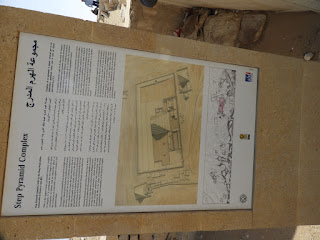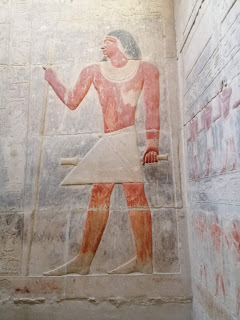After the pyramid visit we had
yet more to cover before we were to head to the station to get the sleeper
train to Luxor.
As we were not very hungry, we
straight away took to route towards Memphis, the ancient capital of Egypt
during Pharaonic times. Memphis was the capital uniting both the upper and the
lower Egypt and located about 24km away from Cairo.
So when we stopped in Memphis it
was almost noon and sunny. So with the tickets we entered the premises after a
security check (Egypt has these security checks at all locations).
According to a commonly accepted
tradition, Memphis was founded about 2925 BCE by Menes, who supposedly united
the two prehistoric kingdoms of Upper and Lower Egypt. The original name of the
city was the White Walls, and the term may have referred originally to the
king’s palace, which would have been built of whitewashed brick. Ptah, the
local god of Memphis, was a patron of craftsmen and artisans and, in some
contexts, a creator god as well.
The first artifact to see was the
giant statue of the king Ramesses II inside the museum. It is about 13m long
and is made up of limestone.
The premises also has a giant
sphinx made of alabaster that belongs to the new kingdom. Among the others are
the statue of the triad of Ptah, Sekhemat and Nefertem, various other parts of
statues, tablets and capitals and bases of columns. They were built from alabaster,
granite and marble.
After spending about one hour, we
moved to Saqqara to see the step pyramid complex. On our way we stopped at a
road side fruit seller to buy some oranges, apples and bananas as we were
feeling hungry.
It is an immense necropolis located
west of the ancient city of Memphis. This has been used as a burial ground
during the ancient times. Site stretches for about 6km. It is best known for
the step pyramid that was built during the 3rd dynasty by Imhotep
for king Djoser. This is believed to be the first stone work done by the
ancient Egyptians. The Djoser complex is surrounded by a wall of light Tura
limestone 10.5 m high.
Apart from the pyramid it
contains a burial chamber, a temple, serdab court (a small enclosed structure
that housed the ka statue) and a Heb-sed court (a space in which the king could
perform the Heb-sed ritual in the afterlife). The remaining chapels on the west
side are decorated with fluted columns and capitals flanked by leaves. Each of
the chapels has a sanctuary accessed by a roofless passage with walls that
depict false doors and latches. Some of these buildings have niches for
statues.
The superstructure of the Step
Pyramid is six steps and was built in six stages. The pyramid began as a square
mastaba (this designation as a mastaba is contended for several reasons) which
was gradually enlarged, first evenly on all four sides and later just on the
east side. The mastaba was built up in two stages, first to form a four-stepped
structure and then to form a six-stepped structure, which now had a rectangular
base on an east–west axis.
After the step pyramid complex we
moved few kilometers away from it to visit some tombs in the area. They were
named as the tombs of Ti, Princess Idut, Kagemni, Mererika and so on who were
either members of the royal family or some high ranking officials. You need to
pay extra if you want to get photographs inside. Special one to remember is the
joint tomb of Khnumhotep and Niankhkhnum.
The walls were covered with
pictures of scenes of everyday life. There are scenes of hunting, baking,
dancing, offerings. Some have animals such as hippopotamus, birds, and
crocodiles. Some of the colours are still well preserved. In the mastaba of Mehu
on the wall to the right of this corridor, there is a door that leads to the
wide courtyard that hosts two large pillars with reliefs of Mehu on both sides.
On the back of these two pillars, there is the false door leading to the tomb
of Kahotep, Mehu's son.
There was a lot of information
that was given by our guide which was hard to digest. The pictures tell many
stories and reveal many information about the everyday life in Egypt.
There were two visits for us to
do, visit to a carper factory and papyrus factory. These are tourist
attractions and they will teach you how these are made and you can purchase any
souvenirs that you like at a good price. We bought some Papyrus scrolls and my
friend who was such a lover of carpets had to satisfy herself with a small
piece as the prices were too much to spend.
After a long and a fruitful day,
we headed back to the hotel from where we packed our luggage and head towards
the railway station to get the sleeper train to Luxor where we were to take our
4 day cruise.




























No comments:
Post a Comment